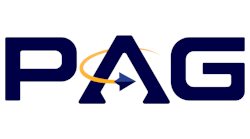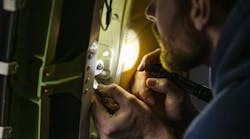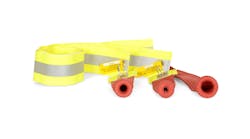The Joint Panel for Aviation Support Equipment (JPAVSE), exists as part of the military’s Aviation Common Systems Board, or ACSB. Its primary focus is to identify common needs for support equipment between the branches of the military, which allows for group development and purchasing of equipment, minimizing both the variety and cost of new systems. Through its efforts, the branches have saved an estimated $100 million to date.
Process
The process through which JPAVSE makes these decisions is split into two steps, the first of which is coordination. At each tri-annual meeting, the principle representative of each branch presents a brief of current and future equipment programs, and emerging technologies which might meet these needs are discussed. This is to ensure that each service is aware of potential programs being explored by other branches, and, using this information, each branch is responsible to provide a response exploring possible intersections of equipment need prior to the next meeting.
Once these potentially overlapping needs have been indicated, the panel can move on to the second step, which is creating a financial proposal based on cost estimates and forecasted savings over the equipment lifecycle. The cost benefits can be widespread, but the main two factors explored are savings based on economies of scale and cost avoidance, whether it be from a single development and testing process, or simplified maintenance programs.
Once a potential program has been approved, the development and production can begin. This can be a long process. Navy Captain Michael Belcher, the Navy’s principal representative on the panel explains, “Typically, for an average program, from start to finish, once we decide we’re going to buy something, to deliver the last item is about seven years.” He adds, “It could be upwards of eight depending on how complex it is, or it could be as little as five, depending on how many you’re buying.”
Before any order can be placed, the military must work with the manufacturer to develop a product that meets all of its needs, and it must then be extensively tested to ensure it performs as designed. Once this extensive development phase is complete, actual production begins.
Belcher elaborates that military orders are often placed in a volume that requires a long production process. He says, “If you’re buying 700 to 800 units of an item, it’s going to take four to five years just to put that production out.”
He also explains that production time can be lengthened by the customization the unique requirements military use entails. The environment on a Navy ramp or in a battle zone demands high performance from equipment. “A lot of the stuff we buy is modified from stuff that’s used out there; it maybe has some unique requirements because of our support environment. We do some things other services don’t have to do,” he says.
Automatic wire test set (AWTS)
The easiest way to explore how significant these cost savings can be is to look at two projects currently being carried out. The automatic wire test set, or AWTS, is one such program. In this program the Navy took a lead role in developing a comprehensive test set which met all of its needs and also happened to fit an Air Force need.
Because the Navy was responsible for the development and testing process, the Air Force was able to purchase this same product without repeating the expenditure, which saved it $320,000, not to mention the quantity price drop the Navy’s order created. At the same time, the Navy also benefited due to the price drop, which a combined order size enabled, saving $750,000. In combination, these two branches saved $2.19 million by coordinating their efforts, not to mention the supply of repair parts, which will be more affordable over the units’ lives due to higher production numbers.
Common radio frequency flight line tester (CRAFT)
Another project currently being carried out through JPAVSE is the production of the AN/USM common radio frequency avionics flight line tester, known as CRAFT. As with the AWTS program, the Navy took the lead in development of this system, but in this situation saw no marked cost avoidance for the price of each unit. This was because the Air Force and Coast Guard only found limited use for the system, and so failed to order in a quantity sufficient to lower the per-unit cost any further, according to Captain Belcher.
While the Navy did not receive per-unit cost savings, by taking the lead in development it allowed significant savings for the other branches involved. Without the combined effort, the development process required to meet the Air Force and Coast Guard’s limited needs would have cost $4.5 million. This, in combination with the quantity pricing created by the Navy’s large order, generated savings of $6.48 million.
Captain Belcher says, “The main objective is to find common solutions to existing requirements. You save money by doing that, economies of scale.” He explains that the benefit is found in “better pricing for the individual units, and you’re sharing in the developmental cost, so each service doesn’t have to pay for that.”
Successes and future
In a situation like the development of the AWTS, savings pass on to every member involved, and there is a direct benefit. Although the Navy paid the development cost, it was more than offset by the per-unit savings the much larger Air Force order made possible, according to Captain Belcher.
In contrast, the CRAFT project was also a success, but for different reasons. The Navy was responsible for both the development and the overwhelming majority of the order, 826 of the 1,006 units ordered, but the Air Force and Coast Guard were able to purchase an effective, reliable system without the prohibitive costs individual development requires.
While the Navy saw no direct benefit, it developed and received a vitally useful system while benefiting other branches of the military. As Betcher explains, “Whoever’s lead would generally bear that expense for the other services to take advantage of. Over the last three years we’ve saved about $9 million by doing some joint projects with the Air Force and Coast Guard.”
As the JPAVSE program continues, more and more potential programs are coming to light. With the enormous savings the panel has enabled, estimated at more than $100 million in the last 15 years, the panel looks to continue its efforts. In addition to the two current projects discussed above, there are eight potential projects in various stages of exploration, and more to come. The panel sees the potential for greater interaction and continued savings as the program continues. Belcher says, “We’ve had some success, but there’s more opportunities to take advantage of.”


